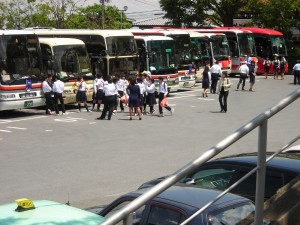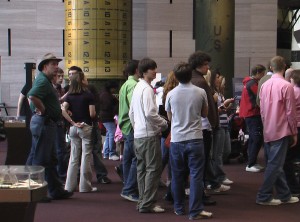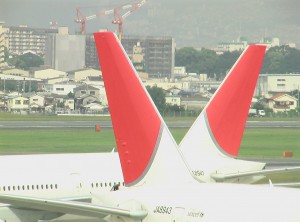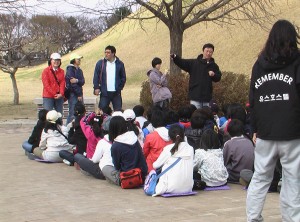Traveling together and organizing the details of the travel are two key elements which leave salient memories for students on field trips.
Although the modes of transport differ somewhat from country to country, students often commented on the comfort or discomfort of the journey. For other site visitors, the rows of buses reveal how popular the sites are with group tours.
 Buses, also, are an easy way to keep the group together and to ensure that everyone has an identical experience.
Buses, also, are an easy way to keep the group together and to ensure that everyone has an identical experience.
In Japan, in recent years, the big bus has ceded some ground to “taxi-tours” and “mini-bus tours” during which the students travel with a guide and which leaves teachers free of obligations. I have had older Japanese complain of this to me, as a lowering of standards.
 It is most common in Kyoto, and not particularly associated with the peace museums and temples.
It is most common in Kyoto, and not particularly associated with the peace museums and temples.
The Shikansen bullet trains also often carry tours, as do planes.
The journey to Okinawa, one of the most common for High School students is, of course, a plane journey. Once on site, most travel takes place by bus.
Americans do travel by bus for environmental, or arts or sports related trips, and they even use buses for amazingly long journeys (from Wisconsin, Nebraska and Kentucky at least) to the historical sites in Washington DC. Travelers from the Mountain and Western States do the trip by plane.
 US travelers at an airport are identifiable as a tour group only by the smallest of signs like luggage tags. Unlike Japanese students, Americans never wear uniforms.
US travelers at an airport are identifiable as a tour group only by the smallest of signs like luggage tags. Unlike Japanese students, Americans never wear uniforms.
Koreans, too, are often dressed in individual not uniform clothes.
In Korea, students almost always travel by bus. The distances are relatively short and, with the exception of high school trips to Jeju Island, bus is often the easiest way to complete the journey door to door. In 2014 the tragic sinking of the Sewol ferry with 350 high school students on board was a reminder that some get to Jeju by sea.
Parental involvement: Surveys indicate that the logistics of these trips are handled by teachers, or teachers working in association with travel agents in Japan and Korea. In the United States parents have much more say. This is a repeating pattern. The only role in these trips for parents in Japan is to pay. In Korea they are sometimes described as playing a role in planning.
 In the US, parents are actively involved, planning, paying and indeed accompanying the students on the trip.
In the US, parents are actively involved, planning, paying and indeed accompanying the students on the trip.




No Comments so far ↓
Like gas stations in rural Texas after 10 pm, comments are closed.